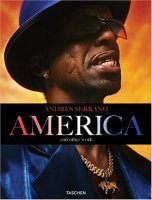Andres Serrano's America
book review by dave heaton

"Even when dealing with reality, I try to make it look like fantasy or theatre." – Andres Serrano
A brief letter from Gore Vidal to Andres Serrano stands as a foreword to Serrano’s America in the deluxe hardcover book which collects America and other work. In the letter, Vidal expresses admiration for the work, but also confusion as to what the images mean when taken together. Significantly, though, he notes that “our weird country and your eclectic images defy encapsulation.” That’s a key point, that it’s not just the images which are hard to get your brain around, but America itself.
America presents portraits of 112 Americans. Suitable to Serrano’s aesthetic style, each portrait is highly stylized – yet with many, though not all, of them, if you isolate the painted color backgrounds and just look at the faces, you can relate to them as real people, with expressions which communicate a feeling. But the purpose is obviously not to present a realistic cross-section of the U.S. citizenry. Among the subjects there are many celebrities (Snoop Dogg, Yoko Ono, Chloe Sevigny, Ethan Hawke, George Steinbrenner) and people of stature within some community (a federal judge, a bishop, a circus ringmaster). There’s also a bull rider, welfare recipients, an AIDS patient, a migrant worker, and a butcher. It’s definitely not just a portrait of high society, but it’s also not a random sampling of Americans. It’s obvious that the subjects were hand-selected, whether it’s because Serrano is fascinated with uniforms and what they say visually, or he’s intrigued by who’s famous for what, or because he’s interested in archetypes and how they relate to real human beings.
Sometimes it’s very apparent that Serrano is placing portraits near each other because he’s interested in the connections between them. Sometimes a facial expression mimics that of the person on the opposing page, or people with an obvious connection will be paired (a cowboy hiding his face is next to a native American, Russell Simmons is next to a KKK director). Overall, though, it’s often quite hard to tell what Serrano’s purpose is. But that’s quite in keeping with his past work. That isn’t to say that his works aren’t suggestive of ideas; they’re often bombarding you with the suggestions of ideas, but it’s hard to grasp onto one overarching concept or theme.
America and Other Works is an impressively comprehensive collection; besides America it includes The Interpretation of Dreams, A History of Sex, The Morgue, Objects of Desire, Nomads, The Klan, The Church, Budapest, Istanbul, Bodily Fluids, Immersions and a selection of his Early Works. For me it serves as a reminder of the strange relationship his photographs have with the world as I experience it. In other words, his forte is making everything look like an advertisement; that causes for feelings of unease or puzzlement when he’s shooting mutilated corpses as colorful objects, (The Morgue) treating homeless people like their fashion models (Nomads), or creating complicated, very theatrical and often purposely disturbing set-ups meant to investigate the complexity of sex (A History of Sex).
About America Eleanor Heartney writes in her introductory essay, "Whether he is depicting a captain of industry or a sex worker, Serrano accords each the full measure of their humanity." That isn’t entirely true, in America or his other works, but it is true sometimes. In Serrano’s work human beings are often treated like tools or objects or setpieces. At the same time there is often real human feelings expressed, but overall Serrano’s mix of formalism and theatricality can make his art feel quite cold, quite distanced from what most people experience as life, in America or elsewhere.
Copyright (c) 2005 erasing clouds |
|